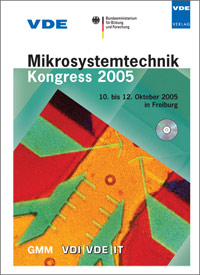Micro- and Nanostructured Organic Electronic Devices
Conference: Mikrosystemtechnik Kongress 2005 - Mikrosystemtechnik Kongress 2005
10/10/2005 - 10/12/2005 at Munich, Germany
Proceedings: Mikrosystemtechnik Kongress 2005
Pages: 4Language: englishTyp: PDF
Personal VDE Members are entitled to a 10% discount on this title
Authors:
Niggemann, M.; Müller, C.; Ruf, D.; Gombert, A. (Fraunhofer Institute for Solar Energy Systems (ISE), Heidenhofstr.2, 79110 Freiburg, Germany )
Bläsi, B.; Riede, M. (Fraunhofer Institute for Solar Energy Systems (ISE), Heidenhofstr.2, 79110 Freiburg, Germany)
Glatthaar, M.; Zimmermann, B. (Material Research Center Freiburg (FMF), Stefan-Meier-Str. 21, 79104 Freiburg, Germany)
Abstract:
Promising advantages of organic electronic devices are their mechanical flexibility, low-cost producibility and light weight. Organic light emitting diodes (OLED) have already been implemented in electronic devices, whereas organic photovoltaic devices (OPV) and organic field effect transistors (OFET) do not yet meet all requirements for commercialization. The architecture of most organic electronic devices is planar, were the semiconducting organic layer is sandwiched between planar electrodes. Implementing micro- and nanopatterned structures in these organic electronic devices offers the possibility to optimize, or even to create novel devices. Large area interference lithography is a promising technology that allows the cost effective replication from masterstructures which is a precondition for commercialization. Two cell architectures were investigated - holographic microprisms and interdigital buried nanoelectrodes. A structure period of 20micrometer in combination with a 2micrometer wide metal grid was chosen for the microprism cells based on the results of electrical calculations. Currentvoltage curves with reasonable fill factors were measured for these devices. A significant light trapping effect was predicted from optical simulations. Interdigital buried nanoelectrodes are embedded in the photoactive layer of the photovoltaic device. Separated interdigital metal electrodes with a sufficiently high parallel resistance were manufactured despite a small electrode distance below 400 nm.


